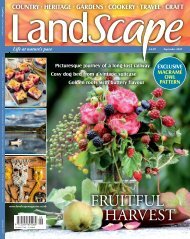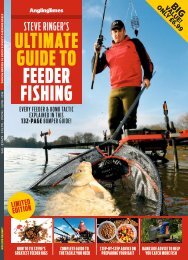Create successful ePaper yourself
Turn your PDF publications into a flip-book with our unique Google optimized e-Paper software.
PART 4 NEW ZEALAND<br />
BIRDS ON THE BRINK<br />
Every issue over the next year, the team behind <strong>Bird</strong> Photographer of the Year<br />
(BPOTY) looks at conservation issues surrounding different species from the UK<br />
and beyond, using beautiful i<strong>mag</strong>es to inspire. This month it focuses on New<br />
Zealand’s birds and wildlife...<br />
WORDS & PHOTOGRAPHY PAUL STERRY<br />
Visitors to New Zealand are<br />
often struck by how similar<br />
the landscape is to the UK<br />
and parts of mainland<br />
Europe, and in many<br />
locations they’re not wrong.<br />
Over the last two centuries or so,<br />
European settlers have had a profound<br />
and devastating impact on the natural<br />
environment, especially in low-lying,<br />
agriculturally-productive lowland areas.<br />
Rolling farmland, scattered trees, and<br />
herds of cows and sheep have replaced<br />
native scrub and woodland in many<br />
areas. And the similarities to ‘back home’<br />
extend to the wildlife, too, of course, to<br />
the extent that introduced plants often<br />
outnumber native species.<br />
Of course, it is not just farming that has<br />
had an impact on New Zealand’s<br />
environment: add to the mix other human<br />
activities, from <strong>mini</strong>ng to logging, and the<br />
result is a much-altered landscape in many<br />
areas. Green and lush it may be, but native<br />
it is not in many places.<br />
One of the most profound impacts on<br />
wildlife is evident in New Zealand’s<br />
<strong>Bird</strong>s on the Brink is a conservation grant-awarding<br />
charity (Charity No: 1188009) that owns the<br />
competition <strong>Bird</strong> Photographer of the Year. Grants<br />
are awarded to projects that support bird<br />
conservation, typically offering between £<strong>20</strong>0 and<br />
£1,000 to small groups or individuals carrying out<br />
grassroots conservation work that has measurable<br />
impact. It was borne of a passion for wildlife and in<br />
particular birds, and is a response to the seemingly<br />
unstoppable process of human environmental<br />
exploitation and biodiversity’s steady progression<br />
towards extinction. At its heart there is a<br />
recognition that all is not yet lost and <strong>Bird</strong>s on the<br />
Brink aims to inspire people to care using striking<br />
i<strong>mag</strong>ery – to capture the i<strong>mag</strong>ination and thereby<br />
nurture interest and compassion. <strong>Bird</strong> <strong>Watching</strong><br />
<strong>mag</strong>azine is proud to support conservation and<br />
money generated by these articles will contribute<br />
to the funds of <strong>Bird</strong>s on the Brink.<br />
For more information, visit<br />
birdsonthebrink.co.uk<br />
avian fauna. Native species evolved for<br />
millions of years in the absence of land<br />
mammals (except bats) until the arrival of<br />
Man, along with a menagerie of cats, dogs,<br />
Stoats, rats, you name it.<br />
As a result, 42% of endemic bird species<br />
have become extinct since Man first set<br />
foot on New Zealand soil. Of the survivors,<br />
only a few could be said to be thriving,<br />
and many are threatened to varying<br />
degrees, with introduced alien birds often<br />
outnumbering natives.<br />
However, this man-made ecological<br />
disaster has made Kiwi conservationists<br />
even more resolute in their determination<br />
to halt the tide of extinctions and where<br />
possible reverse the trend. They are not<br />
ones to take prisoners.<br />
Shore Plover<br />
Shore Plovers are obviously not averse to wandering<br />
and occasionally individuals such as this one sometimes<br />
turn up on the main islands of New Zealand, often<br />
seeking the company of other waders, such as Wrybills,<br />
when roosting.<br />
Shore Plover<br />
Thinornis novaeseelandiae<br />
l World Population: 156-2<strong>20</strong><br />
(source: <strong>Bird</strong>life International)<br />
l IUCN Red List Category:<br />
Globally Threatened,<br />
Endangered<br />
CHRISTCHURCH<br />
AUCKLAND<br />
WELLINGTON<br />
CHATHAM<br />
ISLANDS<br />
Wearing its badge of honour – a ring that defines its<br />
heritage – this particular Shore Plover is resident on<br />
the tiny island of Rangatira, where the species clung<br />
to life until captive-breeding programmes helped it<br />
back from the brink.<br />
Once common around the coast of<br />
New Zealand and its islands, by the<br />
turn of the <strong>20</strong>th Century, the Shore<br />
Plover was reduced to a single<br />
population on Rangatira in the<br />
Chatham Islands; it was on the verge of<br />
extinction. It is still one of the world’s<br />
rarest waders, but captive breeding and<br />
reintroductions mean it now clings on<br />
to survival on a few predator-free<br />
islands; and individuals occasionally<br />
visit the main islands.<br />
South Island Takahe<br />
For a period of 50 years or so the South<br />
Island Takahe (a bit like a giant, flightless<br />
Moorhen) was considered extinct; until<br />
the discovery in 1948 of a tiny population<br />
in New Zealand’s Murchison Mountains.<br />
Since then, ‘wild’ birds have been<br />
protected from predators as far as possible,<br />
and captive-bred birds have allowed the<br />
species’ introduction to predator-free<br />
islands and a few ‘maximum biological<br />
security’ mainland sites. Locations include<br />
spots on North Island where they replace<br />
the now extinct North Island Takahe.<br />
South Island Takahe<br />
Porphyrio hochstetteri<br />
l World Population: 280<br />
(source: <strong>Bird</strong>life International)<br />
l IUCN Red List Category:<br />
Globally Threatened,<br />
Endangered<br />
Chatham Albatross<br />
With a 2<strong>20</strong>cm wingspan, the<br />
Chatham Albatross is a relatively<br />
modest-sized albatross, and a<br />
member of a group sometimes<br />
referred to as ‘mollymawks’.<br />
Nowadays, it breeds nowhere else<br />
in the world, other than on an<br />
isolated rock called The Pyramid,<br />
part of the Chatham Island complex.<br />
It hardly needs saying that this<br />
concentration of life makes it<br />
vulnerable; and fortunately an<br />
outfit called the Taiko Trust (a<br />
non-profit community conservation<br />
trust) has stepped in to help. Over<br />
the last five years, 281 chicks have<br />
been moved to a ‘maximum<br />
security’ predator-free cliff top<br />
(adorned with mock nests and<br />
dummy birds) called The Gap, on<br />
main Chatham Island. The aim is<br />
that the chicks bond with their new<br />
home and establish a new colony.<br />
No luck so far, but time will tell.<br />
Chatham Albatross<br />
Thalassarche eremita<br />
l World Population:<br />
11,000 individuals<br />
(source: <strong>Bird</strong>life International)<br />
l IUCN Red List Category:<br />
Globally Threatened,<br />
Vulnerable<br />
This South Island Takahe now calls Tāwharanui Open Sanctuary, on North Island, home and lives in predator-free<br />
‘freedom’ behind the maximum-security fencing that protects the peninsula from unwanted incursions<br />
Against a backdrop of its sole breeding<br />
site – a lonely rock called The Pyramid –<br />
a Chatham Albatross glides serenely past<br />
The Pyramid, isolated from<br />
the main Chatham Islands,<br />
is the sole breeding site for<br />
Chatham Albatrosses<br />
Like others of their kind, Chatham<br />
Albatrosses are entirely at home at<br />
sea, gliding masters of the air that<br />
seldom need to flap their wings<br />
NEXT<br />
MONTH:<br />
Marsh<br />
Tit<br />
88 <strong>Dec</strong>ember <strong>20</strong><strong>20</strong> birdwatching.co.uk 89

















